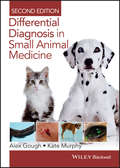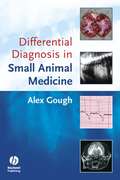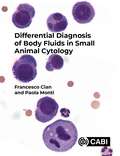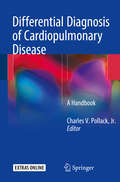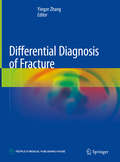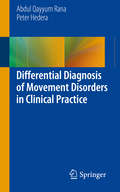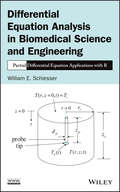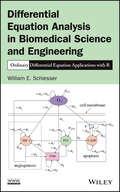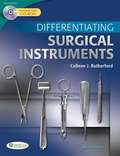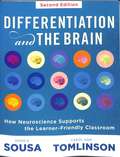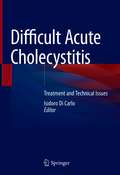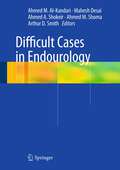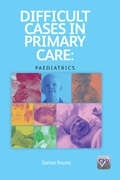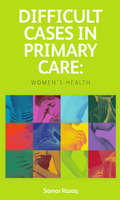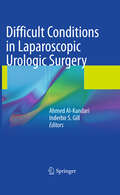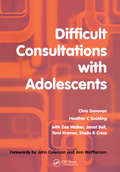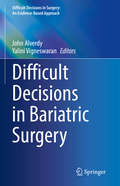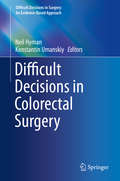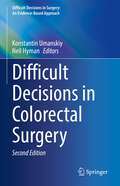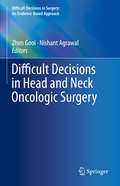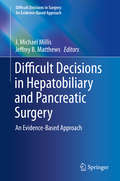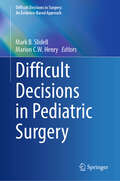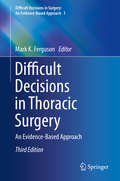- Table View
- List View
Differential Diagnosis in Small Animal Medicine
by Alex Gough Kate MurphyA vital pocket-sized reference tool for busy practitioners and students, saving hours of searching through multiple sources. Differential Diagnosis in Small Animal Medicine, Second Edition brings together comprehensive differential diagnosis lists covering a wide range of presenting signs. This new edition has been fully updated with alphabetised lists for improved navigation. The lists cover the majority of presentations that are encountered in practice, including both common and uncommon conditions.Details differential diagnoses from diverse findings such as history, physical examination, diagnostic imaging, laboratory test results and electrodiagnostic testingProvides guidance on how common conditions are, and how commonly they are the cause of the presenting signUseful throughout the working day for vets in small animal practice, the information will save hours searching alternative multiple referencesNew co-author Kate Murphy brings her expertise as an ECVIM diplomateFor ultimate ease of use this book is also available as an app for iOS and Android devices. To purchase the app visit www.skyscape.com/wiley/DDxSAMed2
Differential Diagnosis in Small Animal Medicine
by Alex GoughVeterinary practitioners and students are presented with many different and complex cases, and are expected to offer an accurate diagnosis quickly. The differential diagnosis list is one of the most important aspects of the problem-oriented approach to clinical diagnosis. Finding good lists in a readily available form can be difficult, and can involve laborious reference to multiple texts and sources. Differential Diagnosis in Small Animal Medicine brings this information together in one place in an easy reference format. A rapid reference that concentrates solely on differential diagnosis lists of major problems in small animal medicine; Details differential diagnoses from diverse findings such as history, physical examination, diagnostic imaging and laboratory test results; Includes radiographs, ultrasounds, selected diagnostic algorithms colour pictures and suggestions for further testing Saves time spent searching multiple texts and sources, by bringing the information together in one place in an easy reference format.
Differential Diagnosis of Body Fluids in Small Animal Cytology
by Francesco Cian Paola MontiIllustrated with high quality photomicrographs, Differential Diagnosis of Body Fluids in Small Animal Cytology provides a comprehensive review of fluid cytology, with an extensive visual atlas. With key points describing the main clinical and cytological features of each pathologic condition, the book provides lists of causes and differential diagnoses, including handy 'pearls and pitfalls' boxes. It is also enriched by chapters on microbiology testing of body fluids and other advanced diagnostic techniques, making the book a valuable resource for veterinary specialists (in particular clinical and anatomical pathologists), residents, veterinary undergraduate students, and small animal practitioners. Key features Over 180 high-quality photomicrographs. Ideal reference book with concise descriptions of each pathologic process. Organised into key bullet points to facilitate use during diagnostic work, or as a revision aid.
Differential Diagnosis of Cardiopulmonary Disease: A Handbook
by Charles PollackThis clinical handbook is designed to aid with the fast and accurate diagnosis of cardiopulmonary disease. Chapters are structured to support the clinical decision-making process and cover key points such as differential diagnosis, typical and atypical presentation, co-morbidities, and critical steps that should not be missed. The text also outlines time-dependent interventions, overall principles of treatment, and disease course. Abundant images and links to external audio and video resources reinforce understanding. Although the chapters are organized to provide ready access to essential information, the scope of the book is comprehensive and addresses topics including acute coronary syndrome, heart failure, pulmonary embolism, primary and secondary lung diseases, and relevant upper gastrointestinal and neuromuscular diseases. Both adult and pediatric considerations are presented. The book is intended for diagnosticians in emergency medicine, critical care, internal medicine, primary care, and related fields. Medical students, residents, and other medical professionals will appreciate the concise and clear approach.
Differential Diagnosis of Fracture
by Yingze ZhangThis book covers diagnostic images of common and rare fractures for nearly every part of the human body, based on a large number of clinical cases. The highlight of this book is that both of three-dimensional X-ray images and CT/MRI images of thousands of fracture cases are presented for comparison and further discussion, according to the framework of AO classification. The first chapter gives a general introduction of various diagnostic imaging techniques for fractures, with attention to their advantages and disadvantages. The following chapters present detailed radiological images of upper extremity fractures, lower extremity fractures, axial skeleton fractures, and epiphyseal lesions. It helps readers to recognize the difference between various diagnostic techniques, and to select optimal imaging techniques. With the illustrative figures, this book is a valuable tool to orthopaedist, radiologists, trauma surgeons, emergency room doctors, professional clinical staff, and medical students.
Differential Diagnosis of Movement Disorders in Clinical Practice
by Abdul Qayyum Rana Peter HederaThis practical, pocket-sized, quick reference book is for those who need to manage movement disorder patients without the immediate help of a movement disorder neurologist. Only the most pertinent information is covered. This book is divided into five chapters covering the common phenomenology of movement disorders and includes tremor, dystonia, chorea, myoclonus, and tics. The etiology, pathophysiology, symptoms and treatments of these conditions are briefly reviewed, with the emphasis on the most common practical challenges encountered with these patients. Differential Diagnosis of Movement Disorders in Clinical Practice is aimed at postgraduates training in neurology, emergency care physicians, internists and primary care providers. Medical students will also find this book particularly helpful during their neurology rotations.
Differential Equation Analysis in Biomedical Science and Engineering
by William E. SchiesserFeatures a solid foundation of mathematical and computational tools to formulate and solve real-world PDE problems across various fieldsWith a step-by-step approach to solving partial differential equations (PDEs), Differential Equation Analysis in Biomedical Science and Engineering: Partial Differential Equation Applications with R successfully applies computational techniques for solving real-world PDE problems that are found in a variety of fields, including chemistry, physics, biology, and physiology. The book provides readers with the necessary knowledge to reproduce and extend the computed numerical solutions and is a valuable resource for dealing with a broad class of linear and nonlinear partial differential equations.The author's primary focus is on models expressed as systems of PDEs, which generally result from including spatial effects so that the PDE dependent variables are functions of both space and time, unlike ordinary differential equation (ODE) systems that pertain to time only. As such, the book emphasizes details of the numerical algorithms and how the solutions were computed. Featuring computer-based mathematical models for solving real-world problems in the biological and biomedical sciences and engineering, the book also includes:R routines to facilitate the immediate use of computation for solving differential equation problems without having to first learn the basic concepts of numerical analysis and programming for PDEsModels as systems of PDEs and associated initial and boundary conditions with explanations of the associated chemistry, physics, biology, and physiologyNumerical solutions of the presented model equations with a discussion of the important features of the solutionsAspects of general PDE computation through various biomedical science and engineering applicationsDifferential Equation Analysis in Biomedical Science and Engineering: Partial Differential Equation Applications with R is an excellent reference for researchers, scientists, clinicians, medical researchers, engineers, statisticians, epidemiologists, and pharmacokineticists who are interested in both clinical applications and interpretation of experimental data with mathematical models in order to efficiently solve the associated differential equations. The book is also useful as a textbook for graduate-level courses in mathematics, biomedical science and engineering, biology, biophysics, biochemistry, medicine, and engineering.
Differential Equation Analysis in Biomedical Science and Engineering
by William E. SchiesserFeatures a solid foundation of mathematical and computational tools to formulate and solve real-world ODE problems across various fieldsWith a step-by-step approach to solving ordinary differential equations (ODEs), Differential Equation Analysis in Biomedical Science and Engineering: Ordinary Differential Equation Applications with R successfully applies computational techniques for solving real-world ODE problems that are found in a variety of fields, including chemistry, physics, biology, and physiology. The book provides readers with the necessary knowledge to reproduce and extend the computed numerical solutions and is a valuable resource for dealing with a broad class of linear and nonlinear ordinary differential equations.The author's primary focus is on models expressed as systems of ODEs, which generally result by neglecting spatial effects so that the ODE dependent variables are uniform in space. Therefore, time is the independent variable in most applications of ODE systems. As such, the book emphasizes details of the numerical algorithms and how the solutions were computed. Featuring computer-based mathematical models for solving real-world problems in the biological and biomedical sciences and engineering, the book also includes:R routines to facilitate the immediate use of computation for solving differential equation problems without having to first learn the basic concepts of numerical analysis and programming for ODEsModels as systems of ODEs with explanations of the associated chemistry, physics, biology, and physiology as well as the algebraic equations used to calculate intermediate variablesNumerical solutions of the presented model equations with a discussion of the important features of the solutionsAspects of general ODE computation through various biomolecular science and engineering applicationsDifferential Equation Analysis in Biomedical Science and Engineering: Ordinary Differential Equation Applications with R is an excellent reference for researchers, scientists, clinicians, medical researchers, engineers, statisticians, epidemiologists, and pharmacokineticists who are interested in both clinical applications and interpretation of experimental data with mathematical models in order to efficiently solve the associated differential equations. The book is also useful as a textbook for graduate-level courses in mathematics, biomedical science and engineering, biology, biophysics, biochemistry, medicine, and engineering.
Differentiating Surgical Instruments
by Colleen RutherfordMore than 800 instruments and tips associated with official names, common nicknames, and descriptions of instrument features, categories, and uses: Common types of clamping, grasping, cutting, and retracting instruments. Instruments for specialized procedures (such as bowel, thyroid or breast surgery). Cutting loops, and the parts that make up cytoscopes and resectoscopes. Orthopedic drills and saw blades. Instruments used in microscopic and endoscopic surgery. Organization based on surgical specialties. "Surgical Sessions" provide chapter review questions and critical thinking scenarios.
Differentiation And The Brain: How Neuroscience Supports The Learner-friendly Classroom
by Carol Ann Tomlinson David A. SousaStudents are becoming more academically and culturally diverse, making it more important than ever to shift away from a one-size-fits-all approach and toward differentiated instruction. The second edition of this best-selling book will help you create truly effective, brain-friendly classrooms for all learners. The authors share an array of updated differentiated instruction examples, scenarios, and exercises, as well as the latest educational psychology research from cognitive psychology, neuroscience, and pedagogy. Learn more about teaching diverse learners using brain-based learning strategies: Explore how the brain learns and approaches to differentiated instruction. Sharpen your knowledge of developmental cognitive neuroscience and educational psychology to teach the best content in the best possible way. Use the knowledge of educational neuroscience (neuroeducation) to benefit the students you teach. Design and implement strategies for effective differentiated instruction. Create a positive and productive learning environment that supports diversity in the classroom. A joint publication of ASCD and Solution Tree
Difficult Acute Cholecystitis: Treatment and Technical Issues
by Isidoro Di CarloThis extensive and yet easy-to-read book covers technical aspects of the management of difficult acute cholecystitis. It discusses diagnostic evaluation, treatment, and strategies for avoiding and managing complications based on both evidence-based data and the experiences of the editor and the international contributors. Further, it analyses the latest guidelines to find the best clinical applications. Each chapter describes the current diagnostic and management strategies, focusing on a possible risk stratification by scores proposed in literature. Lastly, the book describes the relevant technical considerations and tips and tricks, explaining them in full. Illustrated throughout and including line graphs depicting fundamental anatomic and technical principles, making it easy-to understand, it is a useful toolkit for all residents, fellows and general surgeons needing a guide to the treatment of difficult acute cholecystits.
Difficult Cases in Endourology
by Arthur D. Smith Ahmed Al-Kandari Mahesh Desai Ahmed M. Shoma Ahmed A. ShokeirThe book will serve as on demand reference for consultation when one is faced with such special scenario in the field of endourology. It's easy to read and easy to understand format should give an easy access to all chapters right from the beginning, so there is no need to read previous chapters for understanding the current one. Furthermore it will serve as a textbook for problem oriented approach, which will be an interesting and attractive method of teaching.
Difficult Cases in Primary Care: Paediatrics
by Samir RazaqIn many paediatric cases the definitive diagnosis may not be made in the primary care setting, but this is where suspicions are often raised. General Practitioners are, therefore, required to maintain a breadth of knowledge covering the specialty. This invaluable guide outlines a case scenario followed by a highly detailed explanation of the condition and its management, presenting the symptoms in a way that are likely to be encountered in general practice.
Difficult Cases in Primary Care: Women's Health
by Samar RazaqThis concise yet comprehensive guide covers important topics concerning women's health. Using clinical scenarios, the reader can observe how conditions often present in the surgery and understand how they can be effectively managed. Each topic is followed by a self-test question to consolidate knowledge and understanding. The section then concludes
Difficult Conditions in Laparoscopic Urologic Surgery
by Inderbir S. Gill Ahmed Al-KandariDifficult Conditions in Laparoscopic Urologic Surgery outlines potential situations faced by those using laparoscopy and provides solutions for difficult conditions. Extensively and thoroughly written by experts in the field, Difficult Conditions in Laparoscopic Urologic Surgery enables the practising surgeon to confront and resolve dilemmas before even having entered the operating theatre. In this book, every urologic procedure is described using a step-by-step sequence of events and the text is supplemented with numerous tips, colored illustrations and high definition photographs depicting the main steps of the procedures. With a problem-oriented approach, Difficult Conditions in Laparoscopic Urologic Surgery is a valuable reference source for residents, fellows and general urologists.
Difficult Conditions in Laparoscopic Urologic Surgery
by Inderbir S. Gill Ahmed Al-Kandari Raed A. Azhar Arvind P. GanpuleDifficult Conditions in Laparoscopic Urologic Surgery outlines potential situations faced by those using laparoscopy and provides solutions for difficult conditions. Extensively and thoroughly written by experts in the field, Difficult Conditions in Laparoscopic Urologic Surgery enables the practising surgeon to confront and resolve dilemmas before even having entered the operating theatre. In this book, every urologic procedure is described using a step-by-step sequence of events and the text is supplemented with numerous tips, colored illustrations and high definition photographs depicting the main steps of the procedures. With a problem-oriented approach, Difficult Conditions in Laparoscopic Urologic Surgery is a valuable reference source for residents, fellows and general urologists.
Difficult Consultations with Adolescents
by Donovan Chris Heather SucklingThis book will prove an invaluable resource for all those working in the field of primary healthcare and family medicine. Through case histories the reader will be introduced to adolescents who are depressed, to those who have been failed by the system, to those who cannot communicate their needs, and to those for whom issues of confidentiality have become critical.
Difficult Decisions in Bariatric Surgery (Difficult Decisions in Surgery: An Evidence-Based Approach)
by John Alverdy Yalini VigneswaranThis book provides a practical guide to decision making within bariatric surgery. Through uniform and well-structured chapters, topics relating to patient selection, preoperative preparation, the ethics of bariatric surgery, choice of procedure, complications, late failure and management, malabsorptive procedures, and pediatric bariatric surgery are discussed and examined. Difficult Decisions in Bariatric Surgery aims to help readers navigate an increasingly complex surgical specialty and come to reasoned and evidence-based conclusions. This book is of interest to practicing and trainee surgeons, endocrinologists, endoscopists, and pediatricians.
Difficult Decisions in Colorectal Surgery
by Neil Hyman Konstantin UmanskiyThis multi-authored book contains brief chapters devoted to one or two specific questions or decisions in colon and rectal surgery that are difficult or controversial. It is a current and timely reference source for practicing surgeons, surgeons in training, and educators that describes the recommended ideal approach, rather than customary care, in selected clinical situations. Just like the other volumes in this series, the chapters in Difficult Decisions in Colorectal Surgery adhere to a specific format. This approach provides uniformity to the presentations, making it possible to identify useful material at a glance.
Difficult Decisions in Colorectal Surgery (Difficult Decisions in Surgery: An Evidence-Based Approach)
by Neil Hyman Konstantin UmanskiyThis thoroughly revised second edition reflects the exponential growth in the complex field of decision making in colorectal surgery, since the first edition published in 2017. Recommendations are based on newly published data and this book has 30% new additions with 58% chapters completely rewritten by new authors. The chapters in each volume adhere to a specific format. This approach provides uniformity to the presentations, making it possible to identify useful material at a glance.Covering new technology, brief chapters are multi-authored, and each devoted to one or two specific questions or decisions within that specialty that are difficult or controversial. Physicians from nonsurgical specialties give alternative and competing therapies for what was once the exclusive province of the surgeon.
Difficult Decisions in Head and Neck Oncologic Surgery (Difficult Decisions in Surgery: An Evidence-Based Approach)
by Zhen Gooi Nishant AgrawalThis book provides a practical guide to decision making in head and neck oncologic surgery. As new technology is introduced, there is increasing knowledge regarding the efficacy of traditional head and neck surgical therapies and how to select among these varied and complex approaches is becoming increasingly difficult. Concise easy to follow chapters are devoted to one or two specific questions or decisions in head and neck oncologic surgery, aiding the reader to develop their decision making skills. Difficult Decisions in Head and Neck Oncologic Surgery is a timely reference source for practicing surgeons, surgeons in training, and educators on the recommended ideal approaches in selected clinical situations.
Difficult Decisions in Hepatobiliary and Pancreatic Surgery
by J. Michael Millis Jeffrey B. MatthewsThis book is part of a series covering surgical specialties. The volumes are multi-authored, containing brief chapters, each of which are devoted to one or two specific questions or decisions within that specialty that are difficult or controversial. The volumes are intended as a current and timely reference source for practicing surgeons, surgeons in training, and educators that describe the recommended ideal approach, rather than customary care, in selected clinical situations.
Difficult Decisions in Pediatric Surgery (Difficult Decisions in Surgery: An Evidence-Based Approach)
by Mark B. Slidell Marion C. W. HenryPediatric surgery is a demanding specialty that requires not only technical expertise but also exceptional clinical judgment and adaptability. Pediatric surgeons frequently encounter rare congenital anomalies and unusual surgical problems, often requiring them to make difficult decisions with limited precedent. Even well-recognized congenital conditions can present in atypical ways, necessitating a patient-centered approach that may deviate from routine practice. This places a premium on a surgeon&’s ability to apply broad surgical principles to novel and complex situations, tailoring interventions to each child&’s unique anatomy and pathology. Compounding this challenge is the rapidly evolving literature in pediatric surgery, where new techniques, evolving guidelines, and emerging technologies continually reshape best practices. Thoughtful interpretation of the literature is essential, particularly when the optimal approach to a problem remains unclear or controversial. Pediatric surgeons must not only stay abreast of these developments but also critically analyze and synthesize data to make sound, evidence-based decisions in the face of uncertainty. The Difficult Decisions in Surgery series was developed to address many of these challenges faced by surgeons. To date, 10 volumes have been published, receiving enthusiastic engagement from the surgical community. These multi-authored volumes consist of concise chapters, each focused on a specific difficult or controversial decision within a surgical specialty. This series is particularly well-suited for pediatric surgeons, as it provides insight into difficult decisions faced within the field. The volumes serve as a timely reference for practicing surgeons, trainees, and educators, emphasizing the ideal approach to selected clinical situations rather than merely reflecting customary care. Recommendations are grounded in published evidence, while also incorporating expert opinions and personal experiences, helping surgeons navigate complex, evolving literature and apply general surgical principles to novel pediatric challenges. The chapters in each volume adhere to a specific format. This approach provides uniformity to the presentations, making it possible to identify useful material at a glance: a brief general introduction and description of the Difficult Decision laid out using PICO formatting· a brief description of the literature search process. a summary of available published evidence and discussion of the findings. the author&’s personal view of the data and approach to the problem and why they do (or don&’t do) things found in the presented literature. the chapter authors were selected from experts around the world. the editors for this volume were selected from among internationally renown faculty at The University of Chicago and The Johns Hopkins University.
Difficult Decisions in Surgical Ethics: An Evidence-Based Approach (Difficult Decisions in Surgery: An Evidence-Based Approach)
by Peter Angelos Vassyl A. Lonchyna Peggy KelleyThis book provides a detailed guide to the ethical considerations involved when making decisions in surgery. Chapters feature a uniform format, which feature a case that represents a real-life problem, discussion of the medical indications of that issue, the latest available medical solutions, and related ethical considerations. In some cases, more in-depth debate is provided on why a particular decision should or should not be made based-upon ethical principles. Information boxes containing key statements and relevant data in clear easy-to-digest tables facilitates the reader in being able to assimilate the most important points covered in each chapter. Difficult Decisions in Surgical Ethics: An Evidence-Based Approach is a thorough review of ethical considerations in a range of surgical scenarios encompassing both adult and pediatric topics, training surgical residents, ethical care during a pandemic, critical care, palliative care, sensitivity to religious and ethnic mores, clinical research, and innovation. It is intended to be a vital resource for practicing and trainee surgeons seeking a comprehensive up-to-date resource on ethical topics in surgical practice. The work is part of the Difficult Decisions in Surgery series covering a range of surgical specialties.
Difficult Decisions in Thoracic Surgery
by Mark K. FergusonThe second edition of Difficult Decisions in Thoracic Surgery: An Evidence- Based Approach addresses the growing complexity of decision making in thoracic surgery. More than half of the clinical questions posed in this book are new, and of the questions that remain as holdovers from the previous edition, virtually all have been revised and updated. As new technology is introduced, physicians from nonsurgical specialties offer alternative and competing therapies for what was once the exclusive province of the thoracic surgeon. In addition, there is increasing knowledge regarding the efficacy of traditional thoracic surgical therapies. How to select among these varied and complex approaches is becoming increasingly difficult. Concise chapters are devoted to one or two specific questions, or decisions, in general thoracic surgery that are difficult or controversial. The authors identify relevant publications in their selected topics, grade the quality of the evidence offered by those reports, apply that knowledge to objective management recommendations in an idealized world, and then comment on how they personally use the information in their own clinical practices. The book is a valuable reference source for practicing surgeons, surgeons in training, and educators.
